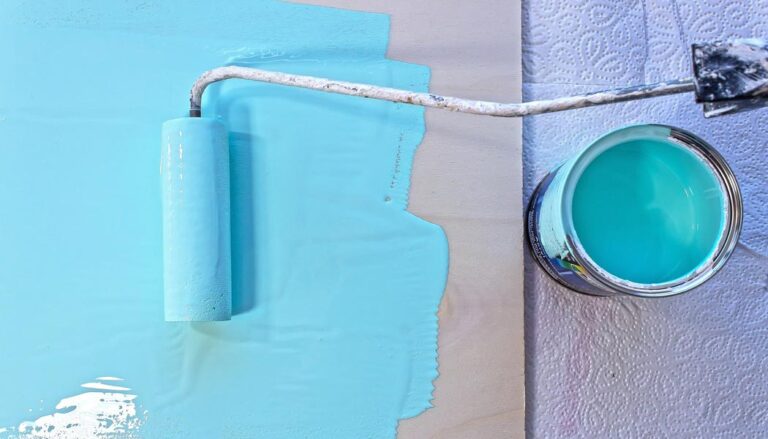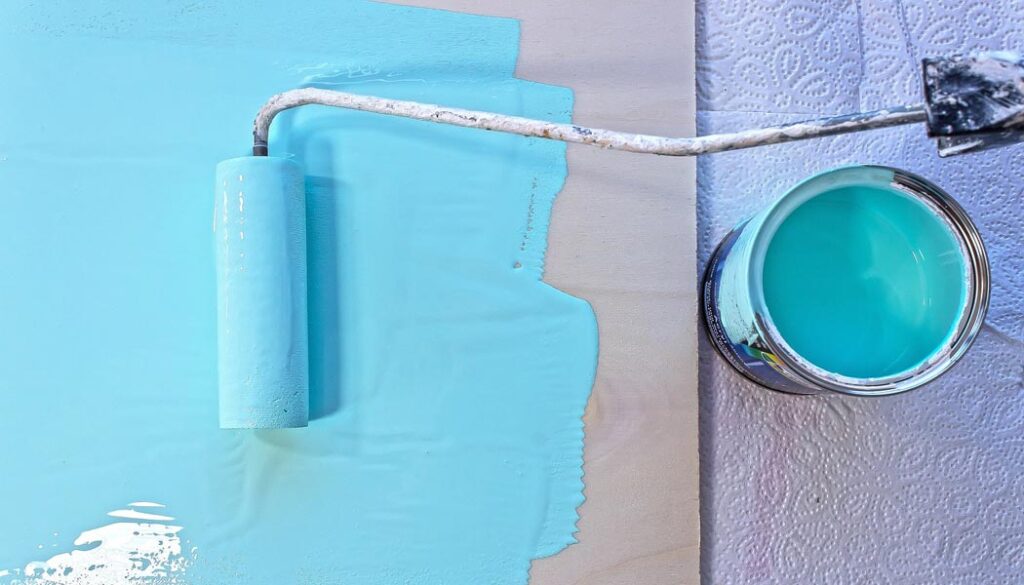
Is Latex Paint Flammable? – Things You Should Know
Welcome, curious readers, to a colorful journey through the world of latex paint! If you’ve ever picked up a can of this versatile substance, you’ve probably wondered: is latex paint flammable? Well, you’re in for a treat because we’re about to dive deep into the fascinating world of latex paint and discover the truth about its flammability.

In this article, we’ll discuss latex paint and its potential fire hazards. We’ll explore its composition, and share some essential tips. These tips will keep you safe while wielding that paintbrush.
So, join us on this illuminating journey as we answer the burning question if latex paint flammable or not.
Is Latex Paint Flammable?
Latex paint, also known as water-based paint, is generally considered non-flammable. Unlike solvent-based paints that use highly flammable solvents, latex paint uses water as its primary solvent. This property significantly reduces its flammability and combustibility.
When latex paint is applied and dried, it releases water vapor as the water content evaporates. This water vapor is not flammable. In addition to water, latex paint contains small amounts of other non-flammable additives, such as pigments and binders.
While latex paint itself is not considered flammable, it’s important to note that some components in latex paints may be combustible when they are in a concentrated liquid or wet state. However, once the paint has fully dried and cured, it forms a stable and non-flammable coating on the surface.
Therefore, latex paint is generally non-flammable. It is a safer option compared to solvent-based paints in terms of fire risk. However, as with any paint, it’s important to follow safety guidelines during application and drying and ensure proper ventilation to minimize exposure to any fumes or emissions.
Is Latex Paint Combustible Or Flammable?
Latex paint is typically non-combustible and non-flammable once it has fully dried and cured. This type of paint primarily uses water as its solvent, which significantly reduces its flammability and combustibility.
During the application and drying process, latex paint releases water vapor as the water content evaporates. This water vapor is not flammable. Additionally, latex paint contains very small amounts of other non-flammable additives.
Certain components in latex paints may be combustible in their concentrated liquid or wet state. They become stable and non-combustible once the paint has dried and cured to form a solid coating.
It is a safer option in terms of fire risk compared to solvent-based paints, which use highly flammable solvents. However, it’s always a good practice to handle any type of paint with care and follow safety guidelines.
Is Latex Paint Flammable when Dry?
Dried latex paint is considered non-flammable. The primary solvent in latex paint is water. It evaporates during the drying process, leaving behind a stable and non-flammable paint film on the surface.
Once the paint has completely dried, it no longer contains flammable components. So, that can’t ignite or support combustion. This makes latex paint a safe option in terms of fire risk when it has reached its cured state.
It’s important to note that while latex paint itself is not flammable when dry, other substances around it may be flammable. Always exercise proper fire safety precautions and keep all flammable materials away from any potential sources of ignition.
Is Wet Latex Paint Flammable?
Wet latex paint is not highly flammable. But it contains small amounts of flammable materials which can be combustible under certain conditions. These VOCs are present in the liquid form of latex paint to aid in the paint’s application and drying process.
VOCs in wet latex paint can potentially be ignited by an open flame or a spark. Their low flash point makes them need to reach a relatively high temperature before they can ignite. The likelihood of wet latex paint catching fire under normal conditions is quite low.
It’s essential to handle wet latex paint with care. Avoid open flames and store them properly to prevent any fire hazards. Always follow the manufacturer’s safety recommendations provided on the paint container.
So, wet latex paint is not highly flammable, but it does contain small amounts of combustible VOCs. While the risk of fire is relatively low, it’s crucial to exercise caution and follow safety guidelines when working with wet paint to minimize any potential fire hazards.
Can Latex Paint Catch Fire?
Latex paint, both in its wet and dry forms, can technically catch fire. The conditions required for it to ignite are not typical in everyday use.
Wet Latex Paint: While wet latex paint contains some flammable components, it has a relatively low flash point. This means it would need to be exposed to high temperatures, open flames, or sparks to ignite. In typical storage and application conditions, wet latex paint is not considered highly flammable.
Dry Latex Paint: Once latex paint has fully dried and cured, it becomes a stable, non-flammable material. The water in the paint has evaporated, leaving behind a solid and inert coating. Under normal circumstances, dry latex paint does not pose a fire risk.
It’s important to emphasize that while latex paint can potentially catch fire under certain conditions, these conditions are unlikely to occur during typical use and storage. However, it’s still crucial to handle and store any flammable materials, including paint, with care and follow safety guidelines to minimize any potential fire hazards.
What Happens If Latex Paint Gets Hot?
When latex paint gets hot, several things can happen. It depends on the extent and duration of the heat exposure. Some probable things that might happen in such situations are-
1. Thickening: Latex paint can start to thicken or become more viscous when exposed to higher temperatures. This is often noticeable when the paint is stored in a hot environment or left in direct sunlight. The heat can cause some of the water content to evaporate, making the paint thicker and potentially more challenging to work with.
2. Separation: Prolonged exposure to heat can cause latex paint to separate. The different components of the paint can settle or separate from the water. This can result in an uneven color and consistency when you try to use the paint.
3. Reduced Shelf Life: Heat can accelerate the aging process of latex paint. Paint exposed to high temperatures may not last long. It should be stored in a cool, dry place. This can affect its performance when applied either.
4. Off-gassing: At higher temperatures, latex paint can release more VOCs into the air. This can lead to stronger odors and potentially affect indoor air quality. It’s important to ensure proper ventilation if you’re working with latex paint in a hot environment.
5. Skin Formation: When latex paint is exposed to heat, a skin or film can form on the surface of the paint in the container. This skin should be removed before using the paint to avoid any lumps or inconsistencies in the paint’s texture.
In summary, exposure to heat can affect the consistency, shelf life, and quality of latex paint. It’s important to store latex paint in a cool, dry place away from direct sunlight and excessive heat to maintain its integrity. If you suspect that your latex paint has been exposed to high temperatures for an extended period, it’s a good idea to check its quality before use to ensure it performs as expected.
Can Latex Paint Withstand Heat?
Latex paint is generally not well-suited to withstand high heat. It is excellent for interior and exterior surfaces. Although there are limitations when exposed to excessive heat.
The main issue with latex paint and heat is that the high temperatures can cause the water content to evaporate. This can lead to several problems like- bubbling and peeling, discoloration, softening, and reduced durability.
To avoid these issues, select the right type of paint for areas that experience high temperatures. For heat-prone areas like kitchens, fireplaces, or radiators, it’s better to use heat-resistant or heat-tolerant paints. These paints are typically oil-based or formulated with special heat-resistant additives.
Although latex paint is versatile, it’s not the best choice for surfaces exposed to high heat. In such cases, opting for heat-resistant paint is a more suitable solution to ensure the longevity and appearance of the painted surface.
Final Words
As we wrap up our discussion on latex paint, we can summarize our lessons. This versatile liquid treasure is not gonna ring fire alarms. In fact, it’s about as non-flammable as your morning cup of water!
So, whether you’re crafting a masterpiece or just satisfying your curiosity, rest assured that latex paint is on your side. As you start your creative attempts, may your brush strokes be steady.
You’re now all set to paint the town without fear of fiery surprises!
